TIME #1: IS OUR RETINA OUR METRONOME?
READERS SUMMARY:
- How does the pupil control how light enters the eye to affect retina?
- How does light link to the autonomic nervous system to affect its tone?
- Is the tone of the autonomic system somehow linked to time?
- What controls the gears of the eye clock?

Many gears called atomic frequencies to control your eye clock mechanism. Artificial light destroys it. Our life is created by shifting gears of frequencies of light at just the right moments of the day and seasons.
Don’t you find it interesting how the human anatomy highlights – full spectrum sunlight? Sunlight has an equal saturation of blue, red, and green. Red light is the antidote for excessive blue light exposure, and our eye camera (vision) is optimized photoptically for green. At night we are designed to use rods which are sensitized to blue light. Purple frequencies (UV) are stored in pigmented cells of the retina and skin for use at night during darkness to refill our cells tensegrity system (piezoelectric) because all cells use ELF-UV light to signal at all hours of the day. If you use UV to signal you have to replace that frequency. We do it via our retina and our skin predominately. Our gut helps in a small way too. Our bodies are like a well-oiled orchestra who uses the sun’s light to create the music in our lives. Night and day our retina changes itself physiologically because of light. At night, during the scotopic vision, the blue light becomes our poison because of the anatomy of the retina and how blue light and melanopsin work with a bright light that is dimming to the coda of night time. It shows you why campfires did not hurt our ancestors. A fire has the relatively the same color temperature of the sun. This implies that our native sun, at night, may not be a problem. This is a big insight into bio hacks. What about our modern version of the alien sun’s around us at night? Is this a good idea to extend our lives?
So what surface does light affect us most at night? It is in our eye at our central retina. How much do you know about that surface?
The pupillary light reflex allows the eye to adjust the amount of light reaching the retina and protects the photoreceptors from bright lights. The iris contains two sets of smooth muscles that control the size of the pupil. These muscles are under autonomic control and they cannot be conditioned by behavior. They respond to characteristics of light. The interesting aspect of the retina surface is that it projects to the central grey matter where the PVN rules the sympathetic system and parasympathetic control of the cranial nerves are housed segmentally in the brainstem.
The sphincter muscle fibers form a ring at the pupil margin so that when the sphincter contracts, it decreases (constricts) pupil size to limit light.
The dilator muscle fibers radiate from the pupil aperture so that when the dilator contracts, it increases (dilates) pupil size to let more light in.
To check the receptor sensitivity (retina) we should only use liminal amounts of light to check the systems tonus. Bright light LED’s alters the tonus of our muscles, as laid out in Ubiquitination 24.
Both groups of these smooth muscles act to control the amount of light entering the eye and the depth of field of the eye. This shows you that pupillary changes and accommodation changes tell us a lot about the local light environment. We, clinicians, need to monitor this in all outpatients carefully too see truly what the retina is being exposed too. It is often different than what the patient reports.

The iris sphincter is controlled by the parasympathetic system, whereas the iris dilator is controlled by the sympathetic system.
The action of the dilator is antagonistic to that of the sphincter and the dilator must relax to allow the sphincter to decrease pupil size.
Normally the parasympathetic sphincter action dominates during the pupillary light reflex. The PVN increases the tone of the wrong side of the eye to create chaos in optical signaling. When it is chronically activated it stop working through fatigue due to chronic calcium efflux in this nucleus. This changes the oscillation it radiates to the central and peripheral nervous system. Since non-native EMF and blue light increase ROS, this means pupillary change tells us about the output or fatigue of the paraventricular nucleus (PVN) from our environment. We’d be wise to pay attention to this. In our labs, the answer is buried in adrenal stress indices with salivary melatonin levels.
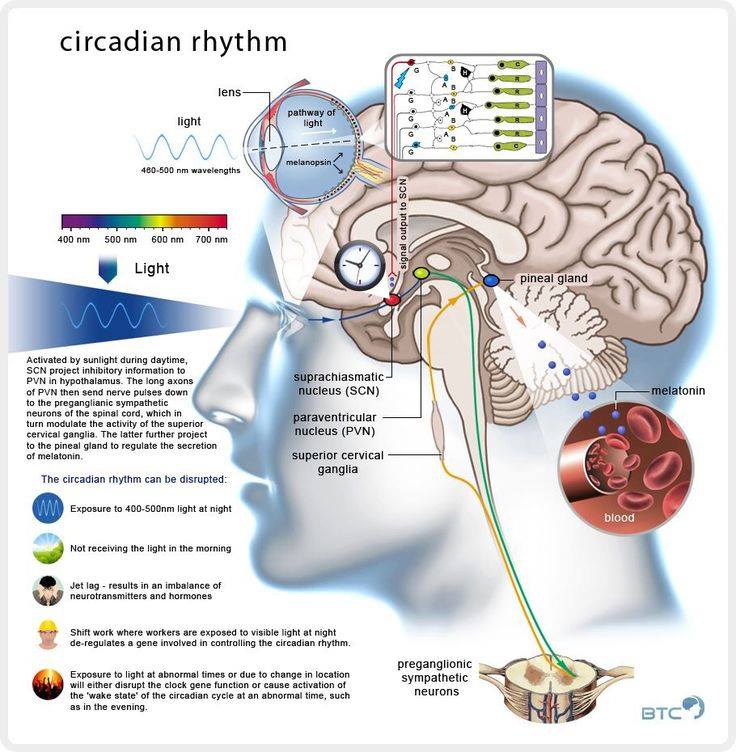
You might recall in Brain Gut 16, I told you this is where adrenal fatigue begins. Does this imply that man’s manufactured “alien sun’s” might be behind adrenal fatigue pandemic? Yes, it does. Blue light alters the central retinal hypothalamic pathways to ruin how the eye clock mechanism works. Blue light destroys many photoreceptors in the body like melatonin synthesis in the eye, gut, and pineal gland. This destroys melatonin signaling in the eye first and then it becomes generalized in the brain stem before it ruins sleep by altering the pineal release of melatonin during scotopic vision at night.
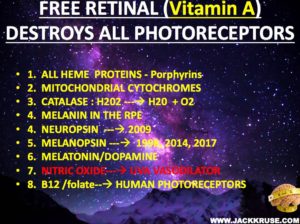
This means that our pupil and our accommodative powers are beacons to the remaining redox potential left in our tissues from our current environment we are choosing to live in. The more blue light we see, the more purple light our cells release, and sicker we get. What helps us make choices in our life? Dopamine levels in the frontal lobes. Dopamine needs UV light to be made optimally. This is powerful information for anyone who lives around the “alien sun” of high color temperature blue/white light in our modern world.

The screens of technology device steal time from your cells because of how the gears of your eye clock were built by Mother Nature.
Analogy time: All the human body is a tube. We are actually “hollow” on the inside with all our cavities filled with different fluids that act like a filament in an Edison bulb. The sheath that separates our body from all the things we stuff in our tube is called the gut “lumen.”
Isn’t it cool that there is a “light shaft” running through our bodies? Have you ever stopped and thought about that aspect of you?
It’s clear that many of our dietary movements/meme’s have no clue about this homology with specific frequencies of light.
Myopics lack UV and IR and have a lot of blue hazard and their eyes have overpowering converging power. This increases the chromatic aberration in their eyes. Converging balance is needed to allow the eye clock mechanism in the central retina to work properly because it is based in the central retina. When it does not work well, converging power alteration has been shown to lower lifespan. The work or Bernstein and Steinhaus showed this in 1920-1945. A longitudinal study was done in 1978 to check this effect.
You must begin to think differently than “their” (food guru’s) ideas to optimize yourself. Life has no remote for light – It expects to see the sun’s version of the solar spectrum, not the manufactured light we make. You must get up and change the light switch yourself, because of this arrangement of evolution. You have to be odd, to be number one for yourself to reach for optimal in a world built with many “alien sun’s”. This is Black Swan wisdom on display.

Are today’s lights what our eyes are ideally adapted too?
We hear a lot “noise” from the food guru’s about how our food supply does not meet what our biochemistry is adapted too. Surface interactions where light strikes us control the deeper layers within us and other surfaces are where light acts upon us. Light controls all aspects of metabolism, so you would think it would make sense to question, is modern light adapted best for our eyes?
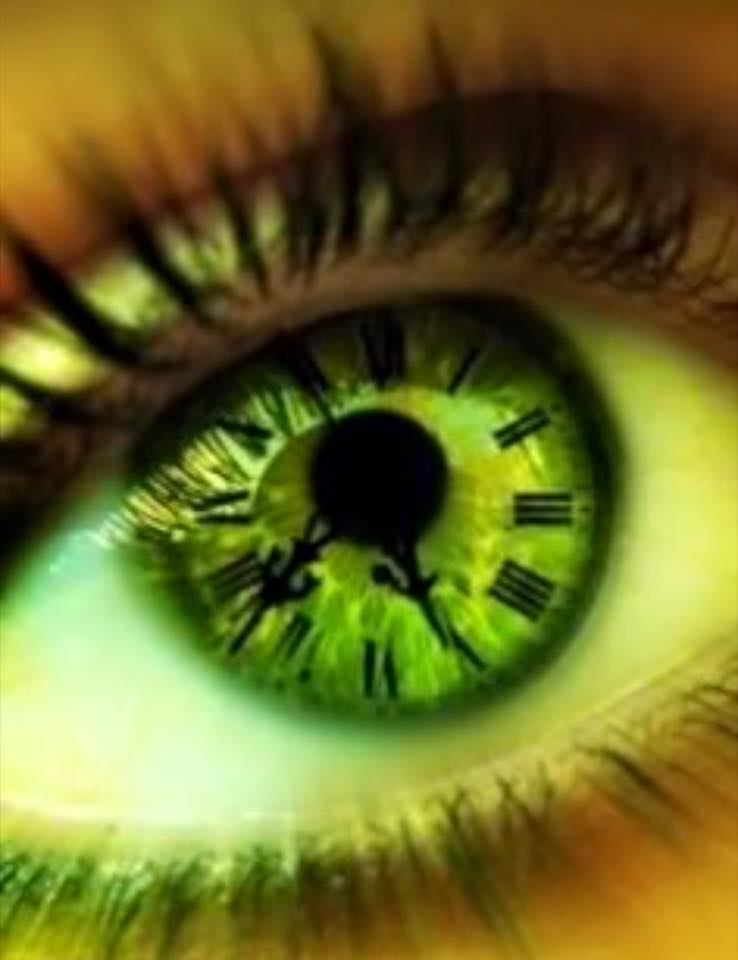
Almost any atom can be caused to emit light by adding energy to it. The light emitted by the atoms of any given element always possesses the same frequency. Atoms also absorb the same frequency of light they emit when they are in the excited state, but not in the path of the incident light that hits the atom. In fact, this relationship is reciprocal. No two elements absorb the same frequency of light. Each atom has a unique light fingerprint because of the quantum numbers associated with subatomic particles.
Some radiators of light are better than others due to their atomic structure and the “relative looseness” of the nucleus and valence electrons. The best radiators of light are always the best absorbers of light.
In a physics lab, the best radiator or absorber of light is called a “black body”. Black body radiators can take two forms:
- A perfect black body is merely a hole. A hole is capable of radiating and absorbing energy simultaneously.
- An imperfect black body would be any darkened surface made by the application of pigment. It is imperfect because the surface results from an inherent quality of the material itself. All imperfect black bodies may either radiate or absorb, never both simultaneously.
The human eye contains both a perfect black body and several imperfect ones. Most of the food guru’s missed these details. The pupil is a perfect black body and as such, it can radiate and absorb at once. This fact is put to good use in ophthalmology and optometry by makers of optical appliances and lenses for the observation of the interior of the eye. I use this every day when I look into an eye to see the retina. The other imperfect black body the eye contains is the choroid. This imperfect black body contains the RPE. The RPE = retinal pigmented epithelium. This imperfect black body absorbs all frequencies of light. Might this be where we collect light to run our eye clock? Yep. In fact, one of the keys to an imperfect black body is that it allows all light that enters the eye to pass through it to hit the retina. Light so absorbed this way is transformed to heat (infrared light).
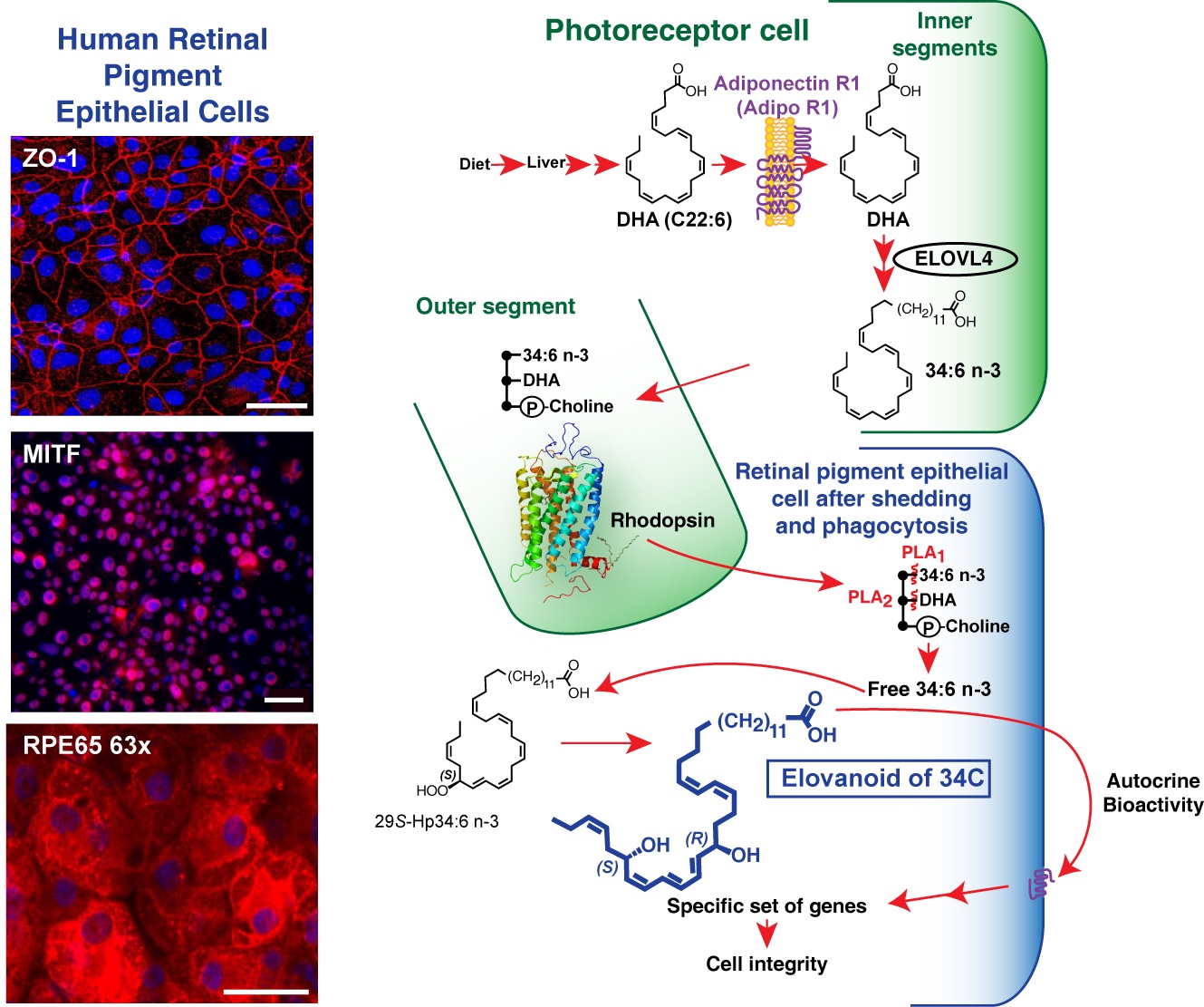
EYE GEEKS: The retina is made up of two main layers. There is an inner layer of ‘seeing cells’ called rods and cones. These cells react to light and send electrical signals down tiny nerve fibers (which collect into the optic nerve) to the brain. The outer layer – the retinal pigment epithelium (RPE) – is a layer of cells behind the rods and cones. The RPE is an insulating layer between the retina and the choroid. These cells help to nourish and support the rods and cones. They pass nutrients from the blood vessels in the choroid to the rods and cones. They also take waste materials from the rods and cones to the blood vessels in the choroid. The RPE can be thought of like a filter, determining what substances reach the retina. Many components of blood are harmful to the retina and are kept away from it by a normally functioning RPE. The rods and cones are responsible for vision in different conditions. There are many more rods than cones, and rods are smaller cells than cones: Rods are also never found in the central retina and dominate the periphery of the retina.
The cone cells (‘cones’) help us to see in the daylight, providing the basis for the color vision of our eye camera.
The rod cells (‘rods’) help us to see in the dark – ‘night vision’ and they form the gears of the eye clock that projects to the suprachiasmatic nucleus to drive circadian signaling.
Experiments have shown the RPE can reach temperatures of 40 degrees C! This heat is in the infrared range and it is transmitted away from the retina quickly by water. That water is in our circulatory system. Water is the ideal chromophore for infrared light because of what part of the light spectrum it absorbs. It turns out the choroid has a massive blood supply to serve this purpose. Ocular melanin protects the retina and choroid of pigmented eyes against light-induced cell toxicity. Melanin is designed to absorb all frequencies of UV light and pass it to porphyrins in RBC’s and to carotenoids in the retina for storage.
Dan Oren, MD, PhD, researcher for Yale University and the National Institutes of Health (NIH) indicated that 50 percent of the entire blood volume in the body passes through the eyes in 40 minutes, and that there is a biochemical mechanism of light involving hemoglobin within the blood (280 nm UV light), allowing the eyes to be an appropriate portal for phototherapy treatment. Nature uses this effect to maintain eye’s ability to provide camera vision. This helps explain why there is such a long distance between the photo-receptors in the eye and the vascular epithelium. The distance is traversed by a massive exclusion zone built in the ophthalmic artery tributaries in the choroid to protect the retina from radiant energy.

So what does this mean when we place a contact or sunglasses in our eyes? How does this affect the perfect black body built in our eye, namely, the pupil? It makes the pupil become an imperfect black body and changes signaling in the retina and brain and set us up for mitochondrial diseases. Contact lenses and glasses filter out all purple light frequencies and this atrophies the eye muscles, allowing the globe elongate. This occurs because we remain unaware of the pupil’s ability to function as a perfect black box radiator. This makes vision less sharp because the more blue light on a relative basis enters the eye. Blue alone causes visual blur as the picture below shows. The retina observes a spectrum of light that is not like the suns. Since blue light also happens to bends the most through the anterior eye this increases visual blur by a process called a chromatic aberration. With bending, blue light falls anterior to the macula to cause visual blur. When you consider that the eye clock uses a blue chromophore called melanopsin you can see the shit storm brewing for man. Few do.
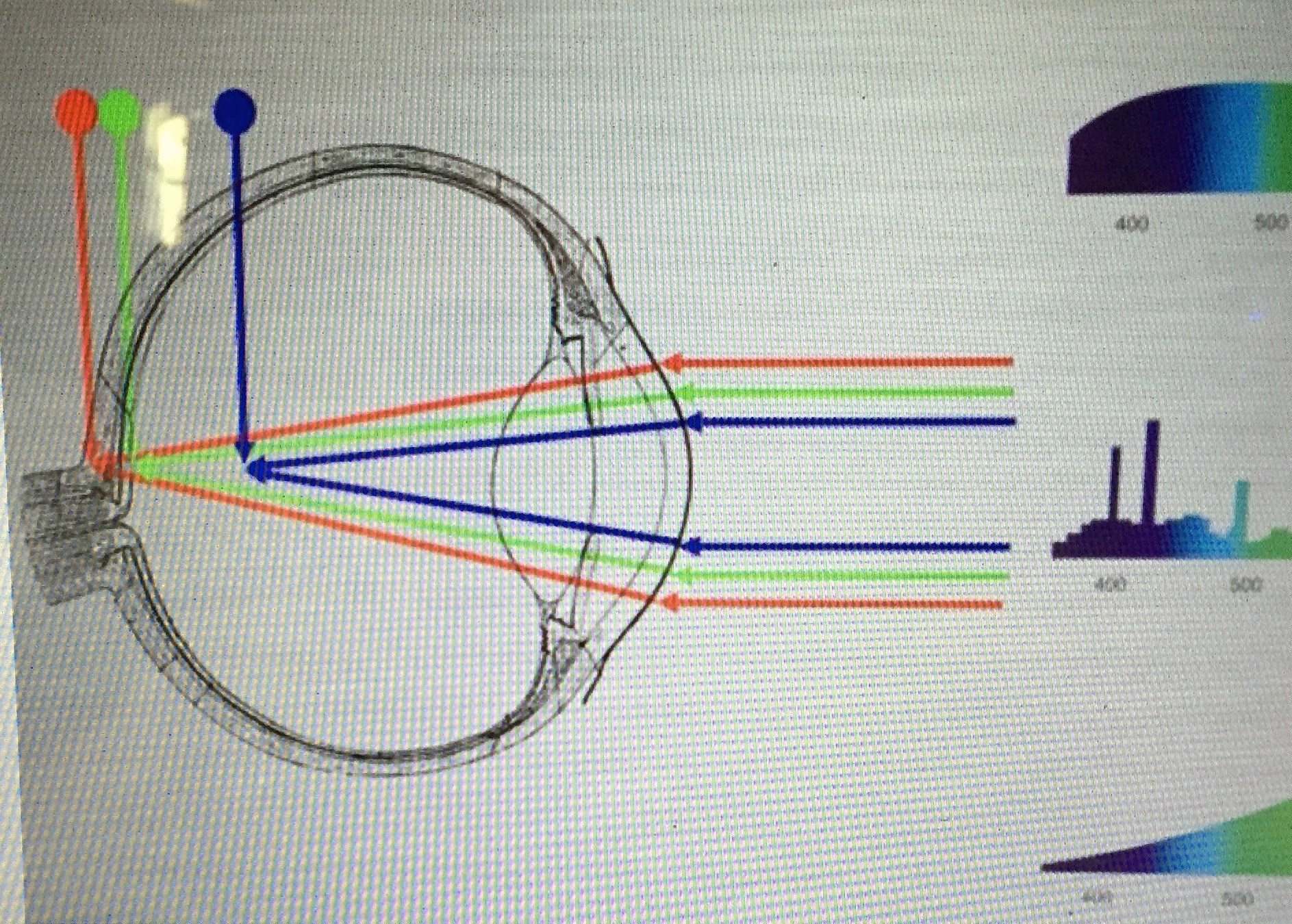
Picture showing how blue light bends to NOT fall on retina normally by chromatic aberration. This is why the central retina is DEVOID of blue photoreceptors. What happens when the more blue light is allowed into the pupil? Your eye clock mechanism breaks down, your retina makes more ROS, and time speeds up for cells.
Visual blur increases when we subtract out purple (UV) and red light (IR). This is why excessive blue light causes a hazard which is often linked to dry and wet macular degeneration. The chronic lack of purple light and red light at the retinal surface has massive effects on the clock mechanism in the eye at the central retina. The more blue light hazard (440-465nm) one gets, the more chance dry macular degeneration occurs. This is because we need a purple light stimulus to hit the retina’s choroid to stimulate blood flow to the surface of the retina just as we do in the skin. When this does not happen blood flow does not come to the surface with its chromophore water. 93% of blood plasma is water. When the eye is missing water, the blue light is still present. Blue light still carries a lot of energy. That energy can no longer be dissipated by the retina and the retina thins over time. This ruins the imperfect blackbody radiator in the eye (RPE). And when it is ruined we can see the effect via the changes in accommodation of the pupil as I mentioned in Ubiquitination 24 blog.

Our eyes are specifically designed to be a full spectrum sunlight bulb. 125 years ago all we have was kerosene lamps, fire from wood, or Edison incandescent bulbs. Sunlight is closer to the light from an incandescent bulb, but nothing can be built by man to replace the light of the sun. Why? Edison bulbs are temperature driven light emitters; our eyes are adapted to light from atomic emissions of light. You know why this is the case?
The chaotic mechanism of the photoelectric effect is the short answer. Later in this series, I will give you a blog on that effect and how it changes us bio-physically using topologic changes. If you want to hear an excellent lecture I gave on this topic go open and Google box and enter my name and Vermont 2017 and a YouTube video will appear. This covers the entire topic. The photoelectric effect is built into our sun’s light. It has atomic sources and not electric arc discharges to create light. The source of incident light creates the speed of electrons that leave surfaces light hits, and that speed of the electrons determines the work that can be done by an electron in our protein lattice. This is the equation life uses to run our clocks.

Illness is the vengeance of nature for the violation of her laws.
TAKE HOME POINT: The light source creates the speed in tissues via Fermat’s principle. More speed = More work. More Work = More Life = more time.
PHYSICS GEEKS: Light we use is collimated from the sun. What the retina receives is light in the visible range only. This spans 260 nm to 700 nm of light. Purple (UV is one edge) and red light (IR) is the other edge of what we can use. The eye camera of the retina is blind to both of these bands of light. The eye clock relies on both frequencies to work optimally. The power factor of the electron varies with its velocity. An electron’s velocity is a function of the frequency of the incident light that frees it. The eye is loaded with DHA and its pi electron clouds. This implies that the work an electron is capable of has pretty wide limits on Earth under the SUN. These frequencies of light are what our retina is ideally adapted too. Electrons set free by the visible range of sunlight can only vary in power from unity to 4 times unity because the frequency of light in the photic range only doubles in this range (260-700 nm). This means life is adapted to work within a single octave of the total electromagnetic spectrum. This relationship occurs because work done by a freed electron varies as the square of the velocity of an electron.
NON GEEKS: The light created from both sources is radically different has massive effects on our retina, pupil, and accommodation of our eyes; ……and our modern light technology is moving us from an atomic sun source to an electric arc “alien sun”. Thusly, forcing our eyes to constantly see LED blue lit bulbs which all have a high color temperature. Anything with excessive blue light spikes increases the color temperature of the light source. This means contacts, sunglasses, and glasses are additive to this effect because they cut UV and IR sources to the retina. These things will change the free radical creation of mitochondria in your central retinal pathways before you eye clock and your leptin receptor. It also predates the dopamine tracts in your frontal lobes changing how your brain operates and works in the environment. In short, IT CHANGES EVERYTHING ABOUT YOUR LIFE. These behaviors combined with these specific types of bulbs are extinguishing our biologic light in our cells. This optical signal causes us to release more ELF-UV from cells. (Roeland Van Wijk 2014) This is happening globally now because municipalities everywhere (1g-5G roll-outs) do not understand light. Moreover, this is just not a human effect; all other life forms because we all work the same way. Life is designed around sunlight, not artificial light. At sunrise, we see visible light with a fine balance of blue and IR in AM sunlight with additions of purple UV in pigmented cells between 10-11 AM throughout our body. The major key is avoidance or long wavelength blue frequencies at night to protect the integrity of our “eye clock mechanism” and limit the collateral damage to our pituitary, PVN, and pineal gland. (435-480 nm)
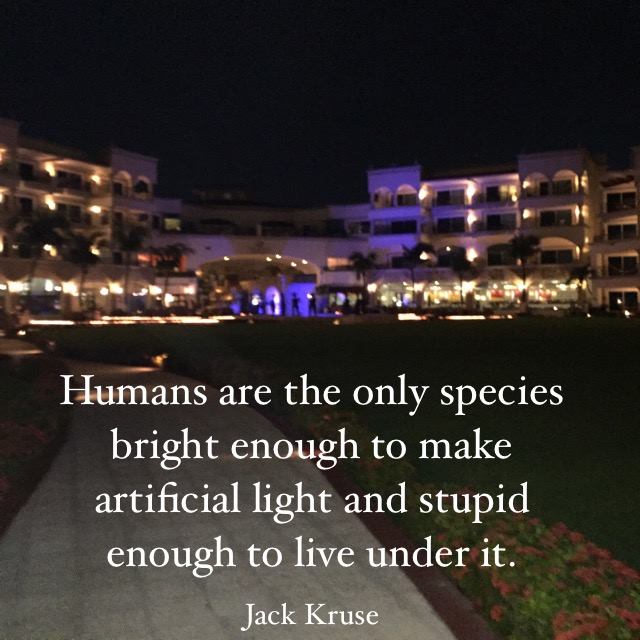
The take away: The Earth is our oasis traveling through space that allows us to look for the sun’s light, not a man-made one. Looking for refuge while at life’s oasis shows a lack of insight. Our ideas are portholes to the sea within us, but we rarely stretch our imagination to see their meaning. Our pupils are portholes that build our brain substance. It can also destroy it, and we don’t even realize it because we focus on the wrong things. We need more light guru’s and not food or exercise gurus. These ideas should quench our thirst for natural wisdom. In a desert, an oasis becomes a beacon, it draws others to us. We are each others oasis; we should tap ourselves and share our drink; we contain the meaning in life, and we bring it to life, life holds no meaning without us. Even a desert shares its bounty in tight regions. It appears our sun does the same to us with respect to the type of light she shares with us. Why waste your time trying to find or create solutions when you are built to contain the best answers nature has prepared? Tap your own well and rebuild your light environment to recapture what you lost.
CITES:
- The Basel longitudinal study on aging (1955–1978) Ophthalmo-gerontological research results
R. Brückner, E. Batschelet, F. Hugenschmidt
2. http://m.jbc.org/content/280/22/21061.full
3. http://www.nature.com/eye/journal/v21/n7/full/6702597a.html
4. http://www.ncbi.nlm.nih.gov/m/pubmed/26464977/
5. http://ocw.mit.edu/courses/earth-atmospheric-and-planetary-sciences/12-141-electron-microprobe-analysis-january-iap-2012/lecture-notes/MIT12_141IAP12_coursenotes.pdf
6. http://www.amazon.com/Light-Shaping-Life-Biophotons-Medicine/dp/9081884328
7. http://www.amazon.com/gp/product/0962689548/ref=pd_lpo_sbs_dp_ss_1?pf_rd_p=1944687702&pf_rd_s=lpo-top-stripe-1&pf_rd_t=201&pf_rd_i=9081884328&pf_rd_m=ATVPDKIKX0DER&pf_rd_r=1RHNXMFAW5TC83SM1T02
8. http://www.amazon.com/Life-Edge-Coming-Quantum-Biology/dp/0307986810/ref=pd_sim_14_1?ie=UTF8&dpID=41q7EHOUI5L&dpSrc=sims&preST=_AC_UL160_SR105%2C160_&refRID=1RHNXMFAW5TC83SM1T02
9. https://www.forbes.com/sites/fionamcmillan/2018/08/11/how-blue-light-damages-cells-in-your-eyes/#50ded043384b
10. https://www.sciencealert.com/how-blue-wavelengths-light-affect-retinal-cell-tissues-eye-disease